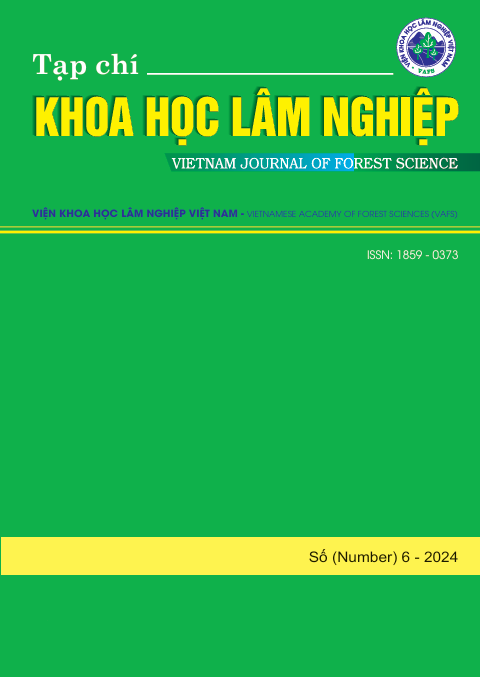EVALUATION OF PRESERVATION TREATMENTS ON THE RESISTANCE TO FUNGUS AND INSECTS OF HYDROTHERMALLY TREATED CINNAMOMUM CASSIA BLUME WOOD USED FOR FINGER-JOINT BOARD MANUFACTURING
DOI:
https://doi.org/10.70169/VJFS.981Keywords:
Wood preservation, finger joint board, preservative treatment, LN5 90SP preparationAbstract
Cinnamon cassia wood is similar to other types of forest wood currently planted in Vietnam, very susceptible to harmful organisms. The results of testing the durability of cinnamon wood before and after hydrothermal treatment showed that cinnamon wood has average durability against termites and woodworms, poor durability against decay fungi, and when tested with discoloration fungi, it was severely damaged by discoloration fungi. Therefore, a preservation treatment method is needed to increase the biological durability of wood. LN5 90SP with the main ingredients of ZnSO4.7H2O and NaF was chosen to preserve cinnamon wood at a concentration of 5%; at 2 levels of wood moisture (about 100% and 70%) and 3 levels of soaking time: 8h, 24h, 48h. The biological durability of cinnamon wood after being treated for preservation against termites, woodworms, decay fungi and color fungi all increased with increasing levels of preservation treatment time. In the 48-hour soaking mode, the preservative molecules permeate and adhere to the cell walls of the wood vessels, making cinnamon wood completely immune to the organisms evaluated in the study. For application as finger joint boards, the preservative-treated cinnamon wood was evaluated for its glue-shear strength and joint breakage strength. The research results showed that there was no significant difference between the preservative-treated cinnamon wood and the untreated wood.
References
John Wiley & Sons, 2007. Wood modification: chemical, thermal and other processes.
Krishnamoorthy B, Rema J., 2004. End uses of cinnamon and cassia. In: Ravindran PN, Babu KN eds. The Genus Cinnamomum. Boca Raton, FL: CRC Press.
Lê Văn Lâm, Nguyễn Thị Bích Ngọc, 2005. Nghiên cứu công nghệ bảo quản chế biến gỗ rừng trồng. Đề tài cấp Bộ Nông nghiệp và phát triển nông thôn.
Luigi Todaro, Roberto Zanuttini, Antonio Scopa, Nicola Moretti. Influence of combine hydro-thermal treatments on selected properties of Turkey oak (Quercus cerris L.) Wood Sci Technol., 2012. Wood Sci Technol 46:563–578. DOI 10.1007/s00226-011-0430-2.
Łukasz Czajkowski1, Wiesław Olek1, Jerzy Weres. Effects of heat treatment on thermal properties of European beech wood, 2020. European Journal of Wood and Wood Products 78:425–431. https://doi.org/10.1007/s00107-020-01525-w.
Muthumala C. K., De Silva S., Alwis P. L. A. G, 2021. Arunakumara investigation of the best joint type for combining of the finger jointed timber panel in board production. In: Proceedings of the 11th international conference on sustainable built environment.
Nguyễn Thị Bích Ngọc, Lê Văn Lâm, Nguyễn Văn Đức, 2006. Tuyển tập công trình nghiên cứu bảo quản lâm sản 1986-2006. Nhà xuất bản Thống kê.
Nguyễn Thị Bích Ngọc, Nguyễn Chí Thanh, Lê Văn Nông., 2006. Bảo quản lâm sản. Nhà xuất bản Nông nghiệp.
Nguyễn Thị Loan, Đinh Khắc Quảng, Nguyễn Văn Truyền, Vũ Văn Đốc, Tạ Thị Phương Hoa, 2017. Nghiên cứu cấu tạo, tính chất gỗ quế và định hướng sử dụng làm thiết bị dạy học và đồ chơi thông minh. Tạp chí Nông nghiệp và Phát triển nông thôn (19) 179 - 185.
Nguyễn Trung Hiếu, Trần Văn Chứ, 2013. Ảnh hưởng của xử lý nhiệt đến tính chất cơ học của gỗ Keo tai tượng trồng tại Hà Giang. Tạp chí Khoa học và Công nghệ Lâm nghiệp số 2:95-104.
Nguyễn Đức Thành, Đỗ Thị Hoài Thanh, Nguyễn Văn Định, Tạ Thị Thanh Hương, 2024. Nghiên cứu đánh giá khả năng hoàn thiện bề mặt ván ghép thanh gỗ quế. Tạp chí Khoa học Lâm nghiệp số 5.
Pan C, Ruan G, Chen H, Zhang D, 2015. Toxicity of sodium fluoride to subterranean termites and leachability as a wood preservative. Eur J Wood Prod 73:97–102
Rezayati Charani, J. Mohammadi Rovshandeh, B. Mohebby, O. Ramezani, 2007. Influence of hydrothermal on the dimensional stability of beech wood. Caspian J. Env. Sci. 5(2)125-131.
Tascioglu, C., Umemura, K., Kusuma, S.S. and Yoshimura, T., 2017. Potential utilization of sodium fluoride (NaF) as a biocide in particleboard production. Journal of wood science 63:652-657.
Trần Thị Huê, 2011. Ảnh hưởng của chế độ xử lý thủy - nhiệt đến một số tính chất vật lý, cơ học của gỗ Keo lá tràm (Acacia auriculiformis). Luận văn thạc sỹ kỹ thuật. Trường đại học Lâm nhiệp Việt Nam.
Trịnh Hiền Mai, Nguyễn Thị Yên, Nguyễn Thị Thắm, 2018. Ảnh hưởng của chế độ xử lý nhiệt đến một số chỉ tiêu tính chất vật lý của gỗ Keo tai tượng (Acacia mangium Willd). Tạp chí Khoa học và Công nghệ Lâm nghiệp số 4:161-166.
Tiêu chuẩn cơ sở TCCS 02:2021/CNR. Chế phẩm bảo quản gỗ: Xác định hiệu lực phòng chống mọt cám nâu.
Tiêu chuẩn Việt Nam TCVN 10753:2015. Thuốc bảo quản gỗ - Phương pháp xác định hiệu lực với nấm hại gỗ basidiomycetes
Tiêu chuẩn Việt Nam TCVN 11355:2016. Thuốc bảo quản gỗ - Xác định hiệu lực chống mối gỗ ẩm–Phương pháp trong phòng thí nghiệm
Tiêu chuẩn Việt Nam TCVN 11356:2016. Thuốc bảo quản gỗ - Xác định hiệu lực chống nấm gây biến màu gỗ-Phương pháp trong phòng thí nghiệm
Tiêu chuẩn Việt Nam TCVN 13707-6:2023. Tính chất vật lý và cơ học của gỗ – Phương pháp thử dành cho mẫu nhỏ không khuyết tật từ gỗ tự nhiên – Phần 6: Xác định độ bền kéo song song với thớ.
Tiêu chuẩn Việt Nam TCVN 8576:2010. Kết cấu gỗ - Gỗ ghép thanh bằng keo - Phương pháp thử độ bền trượt của mạch keo.
Varpa, J., Autio, M., Autio, J. 2024. Sustainable living: Young adults prolonging the material life cycle of objects through the appreciation of used furniture, interiors, and building design. circular economy and sustainability https://doi.org/10.1007/s43615-024-00378-2.
Vũ Văn Thu, Nguyễn Thị Hằng, 2012. Nghiên cứu hoàn thiện công nghệ bảo quản, tẩy nấm mốc gây biến màu gỗ Thông mã vĩ (Pinus massoniana Lamb) ở Lạng Sơn phục vụ sản xuất đồ mộc tiêu dùng trong nước và xuất khẩu. Đề tài khoa học công nghệ ADB.









